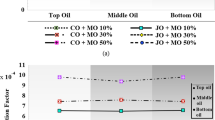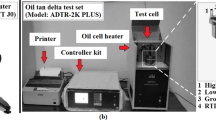Abstract
This article describes an experimental investigation into the AC dielectric strengths of a Jatropha-derived new natural ester (JNE) and compares it with equivalent commercial natural ester (CNE), synthetic ester (SE), and mineral oil (MO) used as a reference sample. The findings indicate that both JNE and CNE have comparable AC breakdown voltages of 74.5 kV and 70.3 kV, respectively, under the test conditions used in this study. However, they exhibit slightly lower breakdown voltages than SE, which displays a breakdown voltage of 79.2 kV. Nevertheless, their AC breakdown voltage is higher than that of mineral oil, which has a value of 68.1 kV. The breakdown voltages of natural esters decreased considerably by around 30% due to aging, unlike SE (~ 17%) or MO (~ 11%). Based on the statistical analysis of breakdown voltage data, it is observed that the Jatropha-derived natural ester (JNE) has a better voltage withstand capacity than the commercial natural ester (CNE) after aging, as the former only showed a 30% decline compared to a 48% decline in the latter.










Similar content being viewed by others
Data availability
The raw/processed data required to reproduce these findings will be made available on request.
References
Martins MAG (2010) Vegetable oils, an alternative to mineral oil for power transformers - experimental study of paper aging in vegetable oil versus mineral oil. IEEE Electr Insul Mag 26(6):7–13. https://doi.org/10.1109/MEI.2010.5599974
Maharana M, Nayak SK, Sahoo N (2018) Karanji oil as a potential dielectrics liquid for transformer. IEEE Trans Dielectr Electr Insul 25(5):1871–1879. https://doi.org/10.1109/TDEI.2018.007230
Williamson C, Timoshkin IV, MacGregor SJ, Wilson MP, Given MJ, Sinclair M, Jones A (2021) Impulsive breakdown of mineral oil and natural and synthetic ester liquids when containing varying levels of moisture. IEEE Trans Plasma Sci 49(1):466–475. https://doi.org/10.1109/TPS.2020.3044133
Das AK, Chavan AS, Shill DC, Chatterjee S (2021) Jatropha Curcas oil for distribution transformer—a comparative review. Sustain Energy Technol Assess 46:101259. https://doi.org/10.1016/j.seta.2021.101259
Beroual A, Sitorus HBH, Setiabudy R, Bismo S (2018) Comparative study of AC and DC breakdown voltages in Jatropha methyl ester oil, mineral oil, and their mixtures. IEEE Trans Dielectr Electr Insul 25:1831–36. https://doi.org/10.1109/TDEI.2018.007219
Baruah N, Dey SS, Nayak SK (2020) Evaluation of dissolved gas analysis and long-term performance of non-edible natural ester. IEEE Trans Dielectr Electr Insul 27(5):1561–1569. https://doi.org/10.1109/TDEI.2020.008768
Baruah N, Nayak SK, Pratihar SK (2021) Quantitative effect of aging duration on dielectric parameters based on frequency response. IEEE Trans Instrum Meas 71. https://doi.org/10.1109/TIM.2021.3127306
Das AK (2023) Investigation of electrical breakdown and heat transfer properties of coconut oil-based nanofluids. Indust Crops Prod 197:116545. https://doi.org/10.1016/j.indcrop.2023.116545
Loiselle L, Mohan Rao U, Fofana I, Jaya T (2020) Monitoring colloidal and dissolved decay particles in ester dielectric fluids. IEEE Trans Dielectr Electr Insul 27(5):1516–1524. https://doi.org/10.1109/TDEI.2020.008719
Yao W, Huang Z, Li J, Chen G, He J, Ahmad J (2018) “Effect of nanoparticles on streamer propagation and breakdown of vegetable oil-pressboard interface in non-uniform electric field. AIP Adv 8:085211. https://doi.org/10.1063/1.5043591
Wang X, Wang ZD (2012) Study of dielectric behavior of ester transformer liquids under AC voltage. IEEE Trans Dielectr Electr Insul 19(6):1916–1925. https://doi.org/10.1109/TDEI.2012.6396948
IEC 60156: 2018 (2018) Insulating liquids - Determination of the breakdown voltage at power frequency - Test method, 3rd edn. p 37
DIN EN 60156 VDE 0370-5:1996-03. Insulating liquids Determination of the breakdown voltage at power frequency - Test method. VDE Art. No.: 0370010
ASTM D1816-12: 2019 Standard Test Method for Dielectric Breakdown Voltage of Insulating Liquids Using VDE Electrodes. p 05. https://doi.org/10.1520/D1816-12R19
Jin H, Morshuis P, Mor AR, Smit JJ, Andritsch T (2015) Partial discharge behavior of mineral oil based nanofluids. IEEE Trans Dielectr Electr Insul 22(5):2747–2753. https://doi.org/10.1109/TDEI.2015.005145
Dang V-H, Beroual A, Perrier C (2012) Comparative study of statistical breakdown in mineral, synthetic and natural ester oils under AC voltage. IEEE Trans Dielectr Electr Insul 19(5):1508–1513. https://doi.org/10.1109/ICDL.2011.6015408
Das AK (2023) Analysis of AC breakdown strength of vegetable oils and effect of mineral oil. Electr Power Syst Res A 214:108920. https://doi.org/10.1016/j.epsr.2022.108920
Khaled U, Beroual A (2019) Statistical investigation of AC dielectric strength of natural ester oil-based Fe3O4, Al2O3 and SiO2 nano-fluids. IEEE Access 60594–60601. https://doi.org/10.1109/ACCESS.2019.2915517
MIDEL eN 1215 (2016) Fluid Maintenance Guide - Distribution Transformers. M&I Materials Ltd., pp 1–2 [Online]. Available: https://www.midel.com/app/uploads/2018/05/MIDEL_eN_1215_Maintenance_Guide.pdf. Accessed 12.04.2021
MIDEL 7131 (2014) Safety data sheet. M&I Materials Ltd., pp 1–5 [Online]. Available: https://inlandvacuum.com/wp-content/uploads/2014/10/Midel_7131_SDS.pdf. Accessed 14 Dec 2021
TRANSOL GIS I Data sheet, Savita Oil Technologies Ltd., India [Online]. Available: https://www.savita.com/businesses/pdf/transol/Transol-GIS-I.pdf. Accessed 12.09.2021
Hosier IL, Guushaa A, Westenbrink EW, Rogers C, Vaughan AS, Swingler SG (2011) Aging of biodegradable oils and assessment of their suitability for high voltage applications. IEEE Trans Dielectr Electr Insul 18(3):728–738. https://doi.org/10.1109/TDEI.2011.5931059
Tenbohlen S, Koch M (2010) Aging performance and moisture solubility of vegetable oils for power transformers. IEEE Trans Power Deliv 25(2):825–830. https://doi.org/10.1109/TPWRD.2009.2034747
Przybylek P (2016) Water saturation limit of insulating liquids and hygroscopicity of cellulose in aspect of moisture determination in oil-paper insulation. IEEE Trans Dielectr Electr Insul 23(3):1886–1893. https://doi.org/10.1109/TDEI.2016.005627
Fofana I, Borsi H, Gockenbach E (2001) Fundamental investigations on some transformer liquids under various outdoor conditions. IEEE Trans Dielectr Electr Insul 8(6):1040–1047. https://doi.org/10.1109/94.971463
Das AK, Shill DC, Chatterjee S (2023) Experimental investigation on breakdown performance of coconut oil for high voltage application. Electr Power Syst Res A 214:108856. https://doi.org/10.1016/j.epsr.2022.108856
Liao R, Hao J, Chen G, Ma Z, Yang L (2011) A comparative study of physicochemical, dielectric and thermal properties of pressboard insulation impregnated with natural ester and mineral oil. IEEE Trans Dielectr Electr Insul 18(5):1626–1637. https://doi.org/10.1109/TDEI.2011.6032833
Vukovic D, Tenbolen S (2009) Comparative evaluation of breakdown strength of natural esters and mineral oil. IEEE International Symposium on High Voltage Engineering, South Africa, pp 603–607
Peppas GD, Charalampakos VP, Pyrgioti EC, Danikas MG, Bakandritsos A, Gonos IF (2016) Statistical investigation of AC breakdown voltage of nanofluids compared with mineral and natural ester oil. IET Science, Measurement & Technology 10(6):644–652. https://doi.org/10.1049/iet-smt.2016.0031
Martin D, Wang ZD (2008) Statistical analysis of the AC breakdown voltages of ester based transformer oils. IEEE Trans Dielectr Electr Insul 15(4):1044–1050. https://doi.org/10.1109/TDEI.2008.4591226
Sima W, Guo H, Yang Q, Song H, Yang M, Yu F (2015) Electric field and space charge distribution measurement in transformer oil struck by impulsive high voltage. Appl Phys Lett 107:082905. https://doi.org/10.1063/1.4929704
Tobias T, Rajnak M, Kopcansky P, Timko M, Agresti F, Barison S, Dolnik B, Rajnak M (2018) Dielectric breakdown study of a nanofluid based on goethite nanoparticles. IEEE Trans Dielectr Electr Insul 25(6):2206–2211. https://doi.org/10.1109/TDEI.2018.007349
Wang X (2011) Partial discharge behavior and breakdown mechanisms of ester transformer liquids under AC stress. PhD Thesis, University of Manchester
Calcara L, Sangiovanni S, Pompili M (2019) Standardized methods for the determination of breakdown voltages of liquid dielectrics. IEEE Trans Dielectr Electr Insul 26(1):101–106. https://doi.org/10.1109/TDEI.2018.007685
Wilson MP, Given MJ, Timoshkin IV, MacGregor SJ, Wang T, Sinclair MA, Thomas KJ, Lehr JM (2012) Impulse-driven surface breakdown data: a Weibull statistical analysis. IEEE Trans Plasma Sci 40(10):2449–2456. https://doi.org/10.1109/tps.2011.2181172
Wang Y, Wang F, Li J, Liang S, Zhou J (2018) Electronic properties of typical molecules and the discharge mechanism of vegetable and mineral insulating oils. Energies 11(523):1–13. https://doi.org/10.3390/en11030523
Wang K, Wang F, Lou Z, Han Q, Zhao Qi, Kelin Hu, Huang Z, Li J (2020) Relationship between the electrical characteristics of molecules and fast streamers in ester insulation oil. Int J Mol Sci 21:974. https://doi.org/10.3390/ijms21030974
Hwang J-WG (2010) Elucidating the mechanisms behind pre-breakdown phenomena in transformer oil systems. PhD Thesis, Massachusetts Institute of Technology
Szwajczakaf E, Szymański A (1986) On the relation between mobility of ions and viscosity. the Walden’s rule. Mol Cryst Liq Cryst 139:253–261. https://doi.org/10.1080/00268948608080131
Wilhelm HM, Tulio L, Jasinski R, Almeida G (2011) Aging markers for in-service natural ester-based insulating fluids. IEEE Trans Dielectr Electr Insul 18(3):714–719. https://doi.org/10.1109/TDEI.2011.5931057
Coulibaly M-L, Perrier C, Marugan M, Beroual A (2013) Aging behavior of cellulosic materials in presence of mineral oil and ester liquids under various conditions. IEEE Trans Dielectr Electr Insul 20(6):1971–1976. https://doi.org/10.1109/TDEI.2013.6678843
Funding
The author is thankful to Science and Engineering Research Board, DST, Government of India (F. No. EEQ/2019/000394), for funding this project.
Author information
Authors and Affiliations
Contributions
Anu Kumar Das is the sole author for this work and has contributed to the following—Conceptualization; Data curation; Formal analysis; Funding acquisition; Investigation; Methodology; Project administration; Resources; Software; Supervision; Validation; Visualization; Roles/Writing—original draft; Writing—review & editing.
Corresponding author
Ethics declarations
Ethical approval
Not applicable.
Competing interests
The author declares no conflict of interest associated with this study.
Additional information
Publisher's note
Springer Nature remains neutral with regard to jurisdictional claims in published maps and institutional affiliations.
Highlights
• Jatropha ester’s AC dielectric strength vs. natural/synthetic esters & mineral oil were compared.
• Natural esters’ breakdown voltages comparable, lower than synthetic ester but higher than mineral oil.
• Aging reduces natural esters’ AC breakdown voltage by 30%, followed by SE (~ 17%) and MO (~ 11%).
• JNE has better voltage withstand post-aging than CNE. JNE declined 30%, while CNE declined 48%.
• Viscosity and ionization potential of TAGs in natural esters significantly influence AC breakdown strength.
Rights and permissions
Springer Nature or its licensor (e.g. a society or other partner) holds exclusive rights to this article under a publishing agreement with the author(s) or other rightsholder(s); author self-archiving of the accepted manuscript version of this article is solely governed by the terms of such publishing agreement and applicable law.
About this article
Cite this article
Das, A.K. Comparative analysis of AC breakdown properties of Jatropha-based ester and other insulating oils: commercial natural ester, synthetic ester, and mineral oil. Biomass Conv. Bioref. (2023). https://doi.org/10.1007/s13399-023-04779-5
Received:
Revised:
Accepted:
Published:
DOI: https://doi.org/10.1007/s13399-023-04779-5




